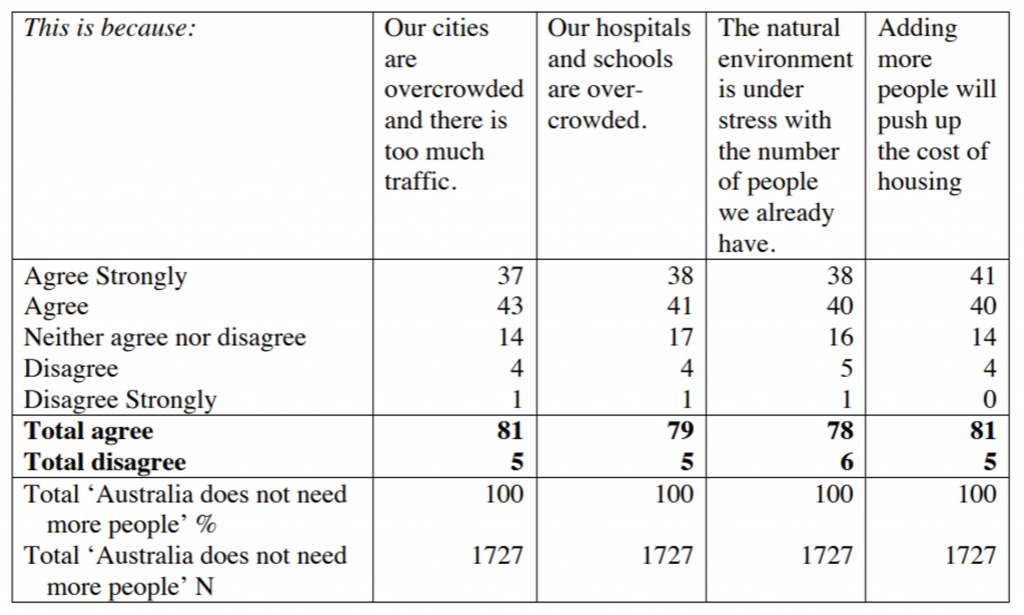
Get set for a major public stoush over immigration
It’s probably no surprise that NSW Premier Dominic Perrottet – now expecting his seventh child, and with 11 siblings of his own – should be in favour of a ‘Big New South Wales.’ And urged on by leading bureaucrats, the new state Premier is backing a five-year doubling of the pre-pandemic migration rate, which he says will help boost the economy. But recent surveys show his views are in stark contrast to those of the general population.
A while ago, I wrote a blog post about Treasury’s 2021 Intergenerational Report highlighting the assumptions of very high levels of immigration for a long period of time. In that post, I also mentioned the result from the survey that The Australian Population Research Institute (TAPRI) did in October 2020. TAPRI has released their updated survey and, given the recent press reports of various politicians, lobby groups and government departments calling for a resumption of high immigration (NSW Treasury and Australian Chamber of Commerce to mention two that have come out publicly recently), I thought it would be interesting to see if anything has changed in the Australian population’s views of immigration.
The first question TAPRI asked “When our borders reopen which of the following would be closest to your views?” and the results show only 19 per cent of the population want to return to the pre-pandemic level of about 240,000 per year while 70 per cent say they want lower levels and 48 per cent want a much lower or even nil level:
The reasons given by the people who said that Australia does not need more people were spread pretty evenly between the impact it will have on infrastructure, concerns for the environment and the upward pressure immigration has on house prices:
I have in a number of blog posts (Should we import cheap foreign workers, or pay locals more?) highlighted how dependent a number of industries in Australia are on cheap imported labour. It is therefore interesting to see the answers to the second question TAPRI asked “Many employers now argue that we must open the borders as soon as possible, to allow temporary and permanent migrant workers in to help the economy. What do you think?” which shows that a large majority of the population do not want to see this happen and instead prefer that these industries deal with worker shortages by becoming more attractive industries to work in for locals (or through increasing productivity as I have argued before):
There have also been strong calls from universities and the wider education sector to re-open borders as quickly as possible for international students. The education sector lobby groups often cite that educating international students is a $40 billion export industry but this is a widely inflated number as I have written about in this blog post. It is interesting to see the population’s reply to the question “Before the pandemic Australia’s universities recruited large numbers of overseas students. In 2018 they made up 32 per cent of all new student enrolments. The universities want governments to allow these numbers to be restored to their pre-COVID levels. Which of the following is closest to your views?” where it seems the average Australian believes that universities have become way to dependent on international students as a revenue source and are not serving domestic students as intended:
Given that both the major political parties are supportive of a high level of immigration, this survey shows there seems to be a big disconnect between what voters want and what most of our elected politicians want. So we question the motivation behind this and ask why there is no public debate about what the right level of immigration is? What is clear though is it is not healthy for our democracy not to have this debate because it will eventually give rise to extreme parties that will approach this issue in less than pleasant language, creating divisions within our society, which is something we should all strive to avoid.
This post was contributed by a representative of Montgomery Investment Management Pty Limited (AFSL No. 354564). The principal purpose of this post is to provide factual information and not provide financial product advice. Additionally, the information provided is not intended to provide any recommendation or opinion about any financial product. Any commentary and statements of opinion however may contain general advice only that is prepared without taking into account your personal objectives, financial circumstances or needs. Because of this, before acting on any of the information provided, you should always consider its appropriateness in light of your personal objectives, financial circumstances and needs and should consider seeking independent advice from a financial advisor if necessary before making any decisions. This post specifically excludes personal advice.
INVEST WITH MONTGOMERY



Andreas,thanks for another excellent & interesting article.
Why do you think the NSW premier wants more immigration if it causes him nothing but headaches and big problems and indeed big $’s as you stated in an earlier Blog article on the 8 July 2021 –
“………………………………..The federal budget benefits from higher population levels as they collect income taxes, but higher population levels have a detrimental effect on state budgets as they are responsible for infrastructure investments.
•
• Thinking about infrastructure, the report also does not mention the negative effects that the average Australian has seen from increases in congestion, higher cost of living from higher house prices etc. …………………………………. ” ??
Hi Adam,
There are a couple of reasons:
1. Politicians and Treasury departments at all levels in Australia are obsessed with GDP growth and not with GDP per capita. Growing GDP by high immigration is the easy way out.
2. The strongest lobby group we have in Australia is the combined interests behind property development and I include building unions in this as well as the property developers themselves and building material companies. To be seen as doing something that is negative for property development would risk mobilise a massive and very powerful interest group.
3. The negative effects of high immigration takes long time to come through so they are not immediately visible.